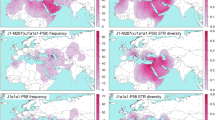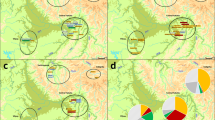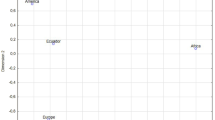A pre-neolithic gene gradation starts in the near East and culminates in western Ireland.
Abstract
Ireland's position on the western edge of Europe suggests that the genetics of its population should have been relatively undisturbed by the demographic movements that have shaped variation on the mainland. We have typed 221 Y chromosomes from Irish males for seven (slowly evolving) biallelic and six (quickly evolving) simple tandem-repeat markers. When these samples are partitioned by surname, we find significant differences in genetic frequency between those of Irish Gaelic and of foreign origin, and also between those of eastern and western Irish origin. Connaught, the westernmost Irish province, lies at the geographical and genetic extreme of a Europe-wide cline.
This is a preview of subscription content, access via your institution
Access options
Subscribe to this journal
Receive 51 print issues and online access
$199.00 per year
only $3.90 per issue
Buy this article
- Purchase on Springer Link
- Instant access to full article PDF
Prices may be subject to local taxes which are calculated during checkout


Similar content being viewed by others
References
MacLysaght, E. The Surnames of Ireland (Irish Academic, Dublin, 1997 ).
Hurles, M. E. et al. Am. J. Hum. Genet. 63, 1793– 1806 (1998).
Whitfield, L. S. et al. Nature 378, 379–380 (1995).
Seielstad, M. T. et al. Hum. Mol. Genet. 3, 2159 –2161 (1994).
Hurles, M. E. et al. Am. J. Hum. Genet. 65, 1437– 1448 (1999).
Jobling, M. A. & Tyler-Smith, C. Trends Genet. 11 , 449–456 (1995).
Jobling, M. A. Hum. Mol. Genet. 3, 107–114 (1994).
Ngo, K. Y. et al. Am. J. Hum. Genet. 38, 407– 418 (1986).
Semino, O. et al. Am. J. Hum. Genet. 59, 964– 968 (1996).
Lucotte, G. & Hazout, S. J. Mol. Evol. 42, 472–475 (1996).
Goldstein, D. B. et al. Proc. Natl Acad. Sci. USA 92, 6723– 6727 (1995).
Heyer, E. et al. Hum. Mol. Genet. 6, 799– 803 (1997).
Hammer, M. F. et al. Mol. Biol. Evol. 15, 427– 441 (1998)
Kayser, M. et al. Int. J. Legal Med. 110, 125– 133 (1997).
Author information
Authors and Affiliations
Corresponding author
Rights and permissions
About this article
Cite this article
Hill, E., Jobling, M. & Bradley, D. Y-chromosome variation and Irish origins. Nature 404, 351–352 (2000). https://doi.org/10.1038/35006158
Issue Date:
DOI: https://doi.org/10.1038/35006158
This article is cited by
-
GREB1 genetic variants are associated with bone mineral density in Caucasians
Journal of Bone and Mineral Metabolism (2018)
-
The Irish DNA Atlas: Revealing Fine-Scale Population Structure and History within Ireland
Scientific Reports (2017)
-
The relationship between surname frequency and Y chromosome variation in Spain
European Journal of Human Genetics (2016)
-
A genetic variant at 12p11 significantly modifies breast cancer risk in a genetically homogenous island population
Breast Cancer Research and Treatment (2015)
-
Familial breast cancer genetic testing in the West of Ireland
Irish Journal of Medical Science (2014)
Comments
By submitting a comment you agree to abide by our Terms and Community Guidelines. If you find something abusive or that does not comply with our terms or guidelines please flag it as inappropriate.



